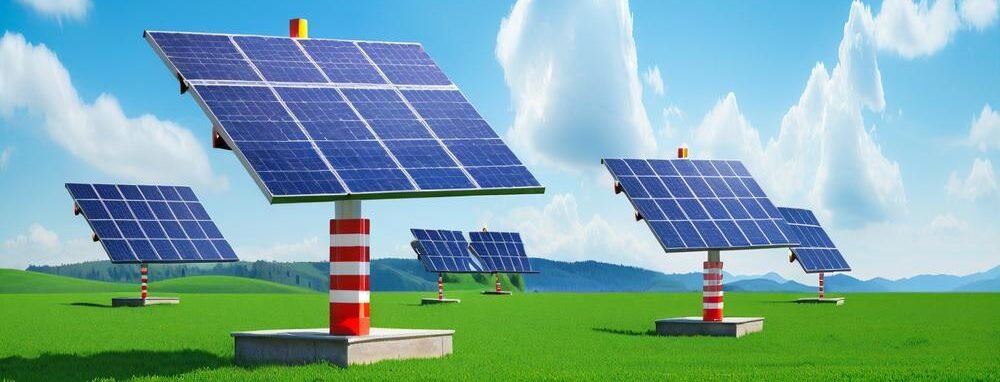
Solar Power Understanding
Description
Solar power is a technology that converts Solar energy into electricity, mainly through Photovoltaics (PV) and Concentrated Solar Power (CSP) two ways to achieve. Here are the details for you:
1.Photovoltaic power generation (PV)
1.1 Working principle
Photovoltaic cells are made from semiconductor materials, such as silicon. When sunlight hits a photovoltaic cell, the photons in the sunlight transfer energy to electrons in the semiconductor, allowing the electrons to escape, resulting in an electric current, a process known as the photoelectric effect.
1.2 Component composition
A basic photovoltaic power generation system consists of photovoltaic panels, which are composed of multiple interconnected photovoltaic cells,in addition, it usually includes an inverter to convert the direct current generated by the photovoltaic panel into alternating current, as well as a bracket structure for installation, a controller to control charging and a battery for energy storage.
1.3 Application field
It is widely used on the roofs of residential and commercial buildings for self-sustaining power generation, and excess power can be sold back to the grid. It is also used in portable electronic devices, such as solar calculators and chargers, as well as large solar power plants that supply electricity to the grid.
2.Concentrated Solar Power (CSP)
2.1 Working principle
Concentrating solar power systems use mirrors or lenses to focus sunlight on a small area, increasing its intensity and generating high temperatures. This heat is then used to produce steam that drives a turbine generator to generate electricity, similar to a traditional thermal power plant.
2.2 Component composition
There are several technology types, including parabolic trough systems, tower systems, and disk Stirling systems,parabolic trough systems use long, curved mirrors to focus sunlight onto a receiving tube that runs along the focal line of the trough,the tower system uses a set of heliostats to reflect sunlight to a central receiver located at the top of the tower,the Disc Stirling system uses a dish mirror to focus sunlight onto the Stirling engine at the focal point.
2.3 Application field
It is mainly used for large-scale power generation and is suitable for areas with high solar radiation, such as deserts. Some concentrated solar plants are also equipped with thermal energy storage systems that continue to generate electricity even when there is no sunlight, providing a more stable power supply.
3.The operating model of solar power
3.1 Distributed solar energy plant operation
Solar power generation equipment is installed at the user end, such as the roofs of residential homes, commercial buildings and industrial plants,in this mode, users can use the electricity generated by themselves to meet their own electricity needs and reduce electricity bills,when there is a surplus of power generation, the excess power can be sold to the grid through grid connection to obtain additional income,operators need to pay attention to the maintenance and monitoring of equipment, ensure the efficiency of power generation and the stable operation of the system, and coordinate with the power grid company to connect the grid and settle electricity charges.
3.2 Large-scale centralized solar energy plant operation
It is usually built in sunny and open land areas, such as deserts and wastelands,the power station has large scale, high power generation, and all the electricity generated is integrated into the grid, and a large amount of electric energy is transmitted to the grid,in the process of operation, a professional operation and maintenance team is required to carry out regular maintenance and overhaul of the equipment of the power station, including the cleaning of solar panels, equipment troubleshooting and repair,at the same time, it is necessary to rationally dispatch power production according to weather conditions and grid needs to ensure the economic benefits of power stations and the stability of power supply.
4.The benefits of solar power
4.1 Environmental benefit
4.1.1 Clean energy
Solar power does not produce greenhouse gas emissions in the process of power generation, nor does it release pollutants, such as sulfur dioxide, nitrogen oxides and particulate matter, which is very friendly to the environment and helps to mitigate climate change and environmental pollution problems.
4.1.2 Sustainability
The life of the sun is billions of years, and solar energy is an inexhaustible renewable energy source. Compared with limited fossil energy, it has obvious sustainability advantages and can provide long-term stable energy supply for mankind.
4.2 Economic benefit
4.2.1 Reduce energy costs
For distributed solar users, installing solar power generation equipment can save a lot of electricity bills in the long run,in some areas rich in light resources, the cost of solar power generation has gradually approached or even lower than the cost of traditional energy power generation, large-scale solar power plants have a certain economic competitiveness.
4.2.2 Job creation
The solar industry from equipment manufacturing, installation and maintenance to related system design and other links, need a lot of manpower, can create many jobs, promote economic development.
